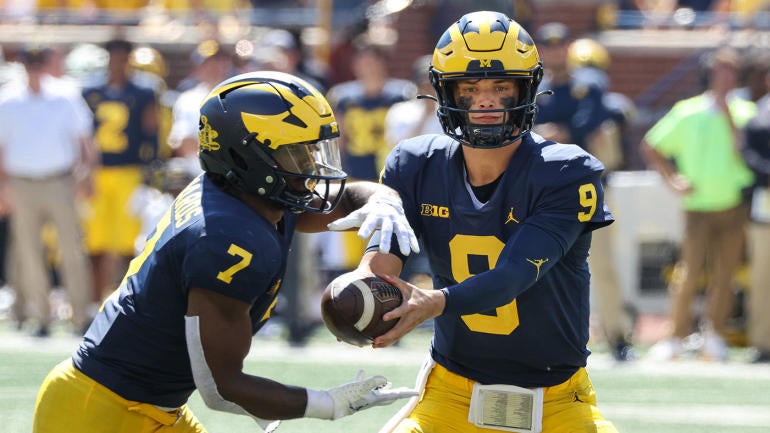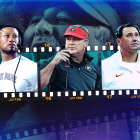
Last year, No. 2 Michigan did something nobody was expecting. After years of struggling to break through against rival Ohio State, the Wolverines knocked off the Buckeyes in Ann Arbor, won the Big Ten and made their College Football Playoff debut. Unfortunately, what was a tremendous achievement for Jim Harbaugh's program didn't have the happiest ending. The Wolverines were blown out by No. 3 Georgia 34-11 in the Orange Bowl. A month later, Harbaugh interviewed for the Minnesota Vikings job on National Signing Day.
Many wondered if the 2021 season would prove to be an outlier. It wasn't. Michigan started 2022 where it left off by blowing out opponents during the regular season. It then spanked the Buckeyes again -- this time in Ohio State's house -- before moving on to crush Purdue in the Big Ten Championship. Now, it's back in the College Football Playoff as the No. 2 seed for the second straight season.
But can the Wolverines improve upon their playoff performance of last season? Can they not only pick up a win and reach the national title game but win the whole thing? While the Wolverines aren't the favorite to do so -- that remains the Georgia team that beat it last season en route to a national title -- it's not out of the question.
Many might believe it is, but those same people never thought Michigan would reach the playoff last year and didn't think they'd get back again in 2022. Yet, here they are, and there is path to success. Here are three reasons why Michigan can be this year's national champion.
1. It upgraded at quarterback
Cade McNamara was a perfectly suitable quarterback for the Wolverines in 2021. He was a talented game manager who was probably capable of doing more than what was asked of him; however, he's not of the same caliber of quarterback you typically see in the College Football Playoff or among the elite teams. Of course, you can say that Georgia was in the same situation with Stetson Bennett last year but still managed to win it all. Still, there's one large difference between Bennett and McNamara (besides the historically great defense Georgia had): Bennett could run. Cade McNamara could not and did not.
Ask any defensive coordinator if they'd rather face a mobile quarterback and they won't take long to answer.
Enter J.J. McCarthy, who brought another dynamic to the Michigan offense this season. Not only did McCarthy put up better passing numbers (McNamara had a passing efficiency of 141.87 with 15 touchdowns and six interceptions last season, compared to McCarthy's 155.42 rating, 20 touchdowns and three picks this season), but he's a much bigger threat with his legs. McCarthy rushed for 254 yards and four touchdowns, but he's capable of doing even more if needed. He can use his legs if a play breaks down in a way that McNamara was never capable of.
It's much easier to defend a team with a quarterback who will remain in the pocket in the run and pass game. When dropping back to pass, a defense knows where the quarterback will be and can plan around it. In the run, a mobile quarterback forces a defense to play 11-on-11 instead of 11-on-10.
McCarthy also provides more stability in the shorter-to-intermediate passing game. McCarthy and McNamara posted similar numbers on throws of 20 air yards or more. McNamara had a higher yards per attempt, but McCarthy threw for a higher rate of touchdowns and a lower rate of interceptions.
On the shorter stuff, however, McCarthy has been a lot better. When throwing passes of 19 air yards or fewer, McCarthy had a passing efficiency of 149.4 with 12 touchdowns and one interception. Last season, on the same throws, McNamara had a rating of 131.0 with 10 touchdowns and six interceptions. In other words, McCarthy can hit the same home runs McNamara did, but he's also much better at hitting the singles and doubles. Not only do defenses have to worry about McCarthy's legs, but they have to worry about the entire field in the passing game.
2. It runs the ball as well as any team
A lot of the credit in Michigan's run game success should go to the offensive line. The unit won the Joe Moore Award, given to the best offensive line in the country, for the second year in a row. It's a big reason why the Wolverines can run the ball effectively no matter who is in the backfield. When handing off to running backs, Michigan ball carriers averaged 2.75 yards before contact per rush. That's the fifth-highest mark in the nation. Michigan's offense ranked fourth nationally in yards per carry at 5.64, fifth in first downs per rush at 31.1%, and fourth in rushing success rate at 50.3%.
Ironically, as football has become more pass-happy, it's nearly impossible these days to win a national title without a strong run game. Michigan has one -- even without Blake Corum, who went down with an injury in Michigan's win against Illinois. Donovan Edwards has since stepped in and been outstanding, rushing for 216 yards (9.82 per attempt) against Ohio State with two touchdowns and 185 yards (7.4 per attempt) and another touchdown against Purdue.
Being able to run the ball allows you to control the game, and it's something Michigan has utilized all season when it gets a lead.
3. Defense doesn't allow opponents to finish drives
You can't win football games without scoring points, and not allowing your opponent to score any helps a lot, too. Michigan was great at both, finishing seventh nationally on offense, scoring 40.1 points per game, and fourth defensively, allowing 13.4 points per game.
Yet, if you look at some of the surface numbers, Michigan's defense seems average. After losing Aidan Hutchinson and David Ojabo, who had 25 sacks and 28.5 TFL between them, Michigan's pass rush dropped off a bit this season. However, the numbers are somewhat misleading. The Wolverines rank 58th nationally in pressure rate (33.3%) and 34th in sack rate (7.7%), but some of that drop-off in performance was about Michigan's approach.
With such big leads, the Wolverines didn't have to bring a lot of additional pressure and often sat back in coverage, forcing opponents to sustain long drives. Then, on the rare occasions the opponent got into scoring position, Michigan snuffed them out. Opponents scored on only 21.1% of their possessions against the Wolverines. That was the third-lowest mark in the country. When they reached the red zone, Michigan's opponents scored touchdowns only 37.9% of the time. That ranked third nationally, too.
It's one thing to get into scoring position, it's another thing entirely to finish the drive. Michigan's defense has been phenomenal at stopping teams from finishing drives.
Making a CFP case for ... No. 1 Georgia | No. 3 TCU | No. 4 Ohio State






















